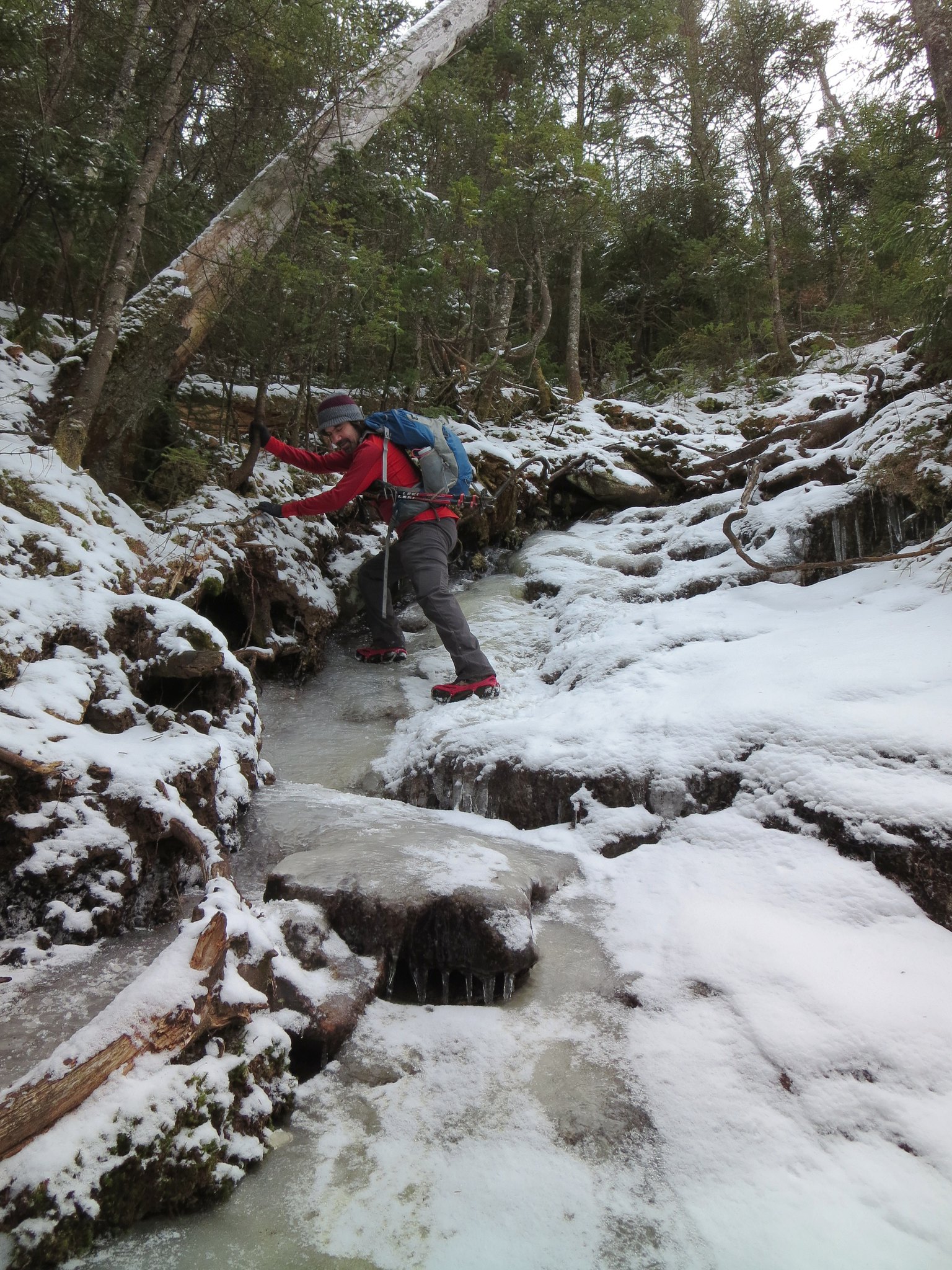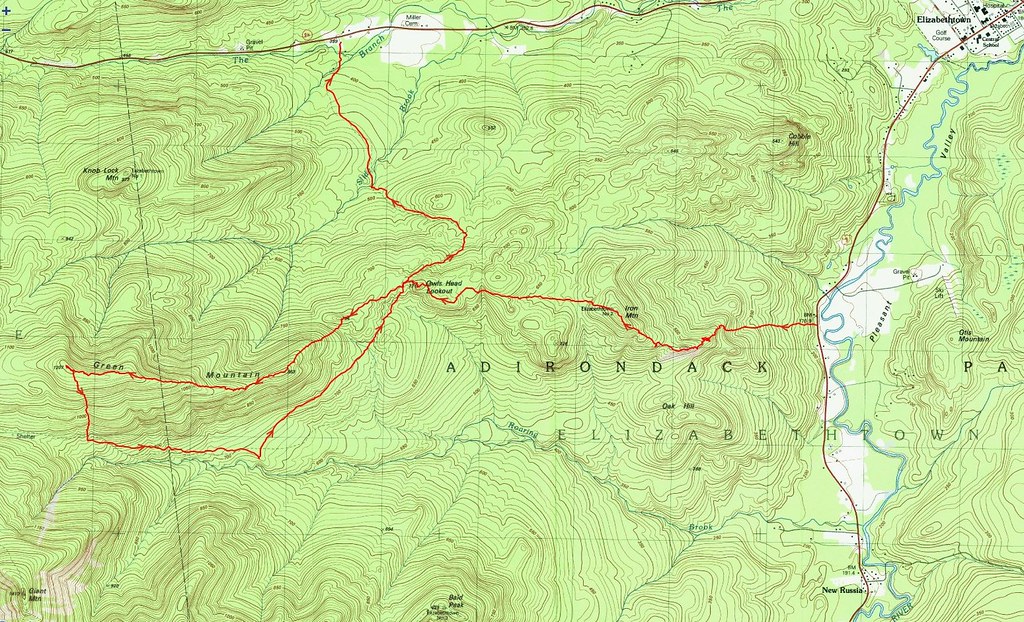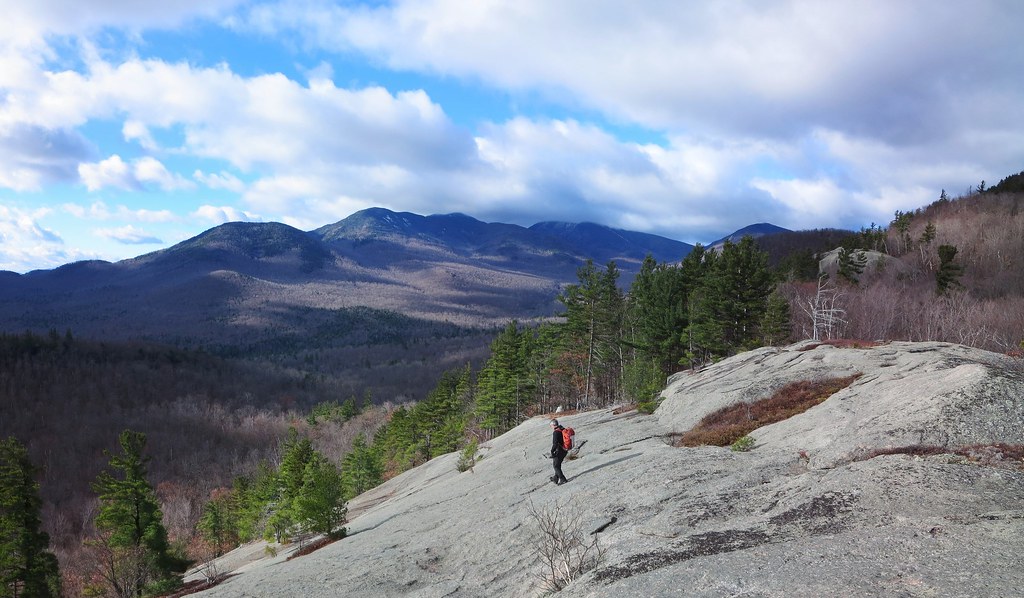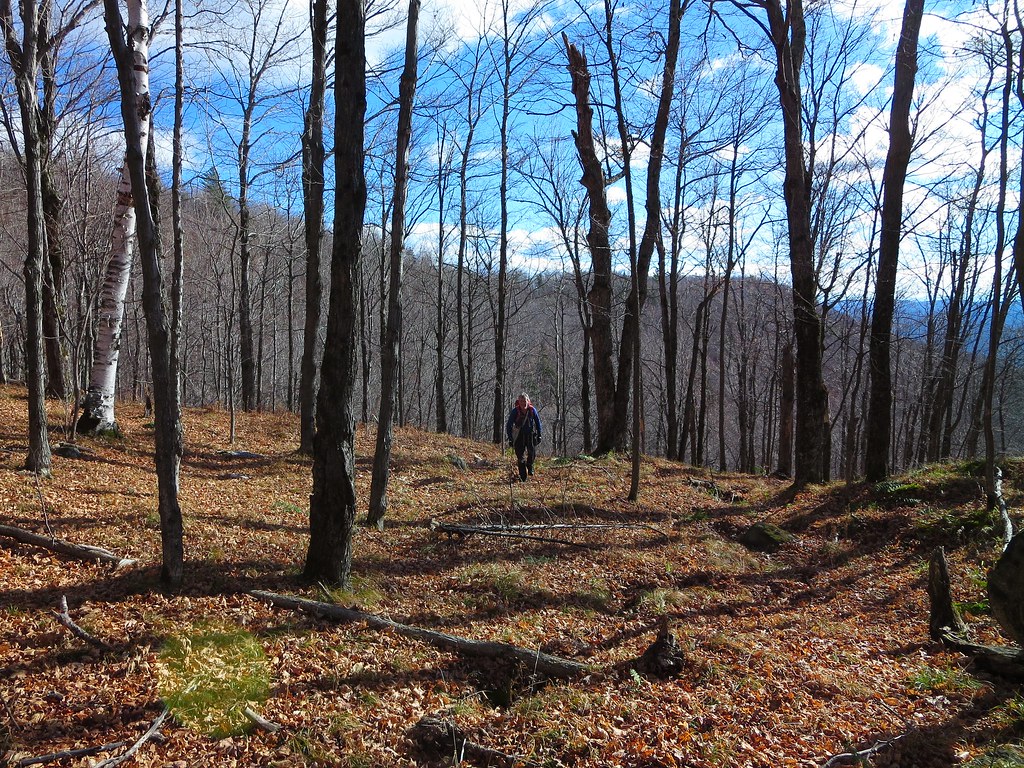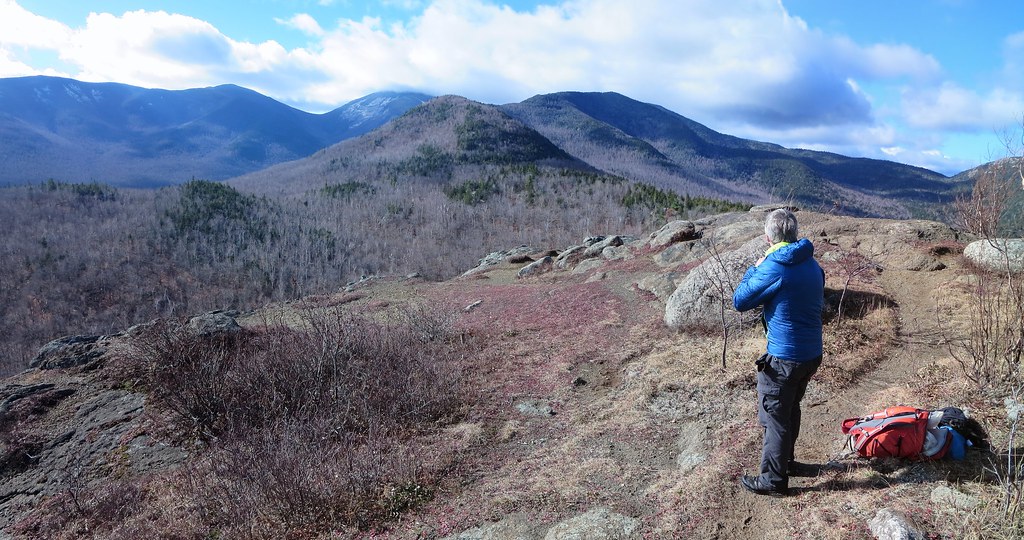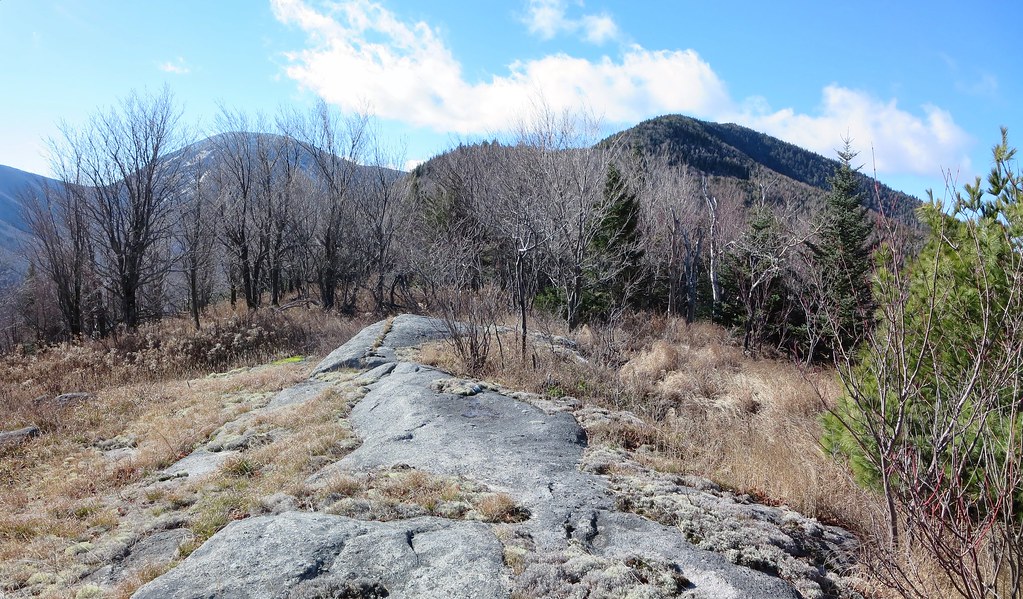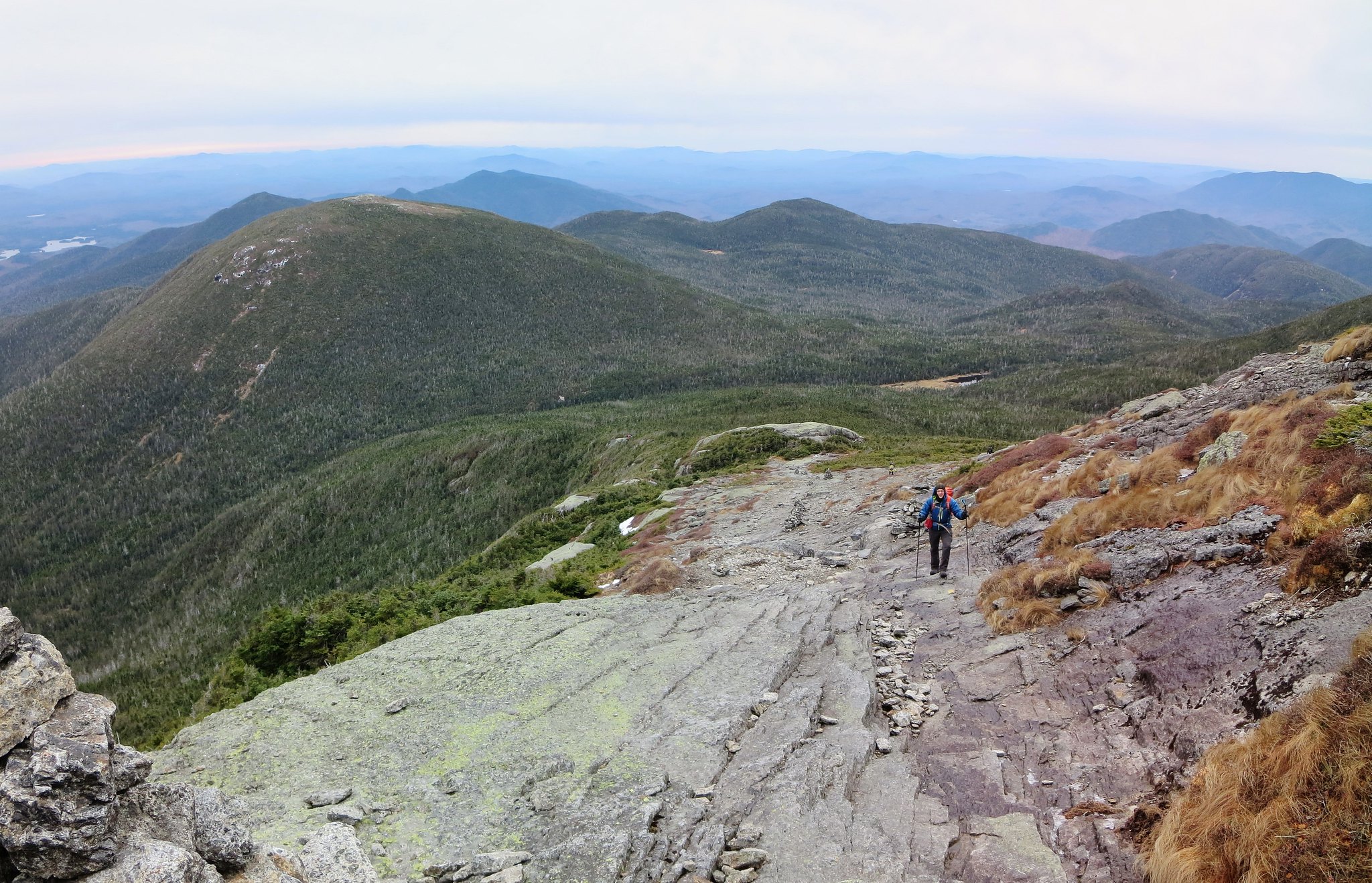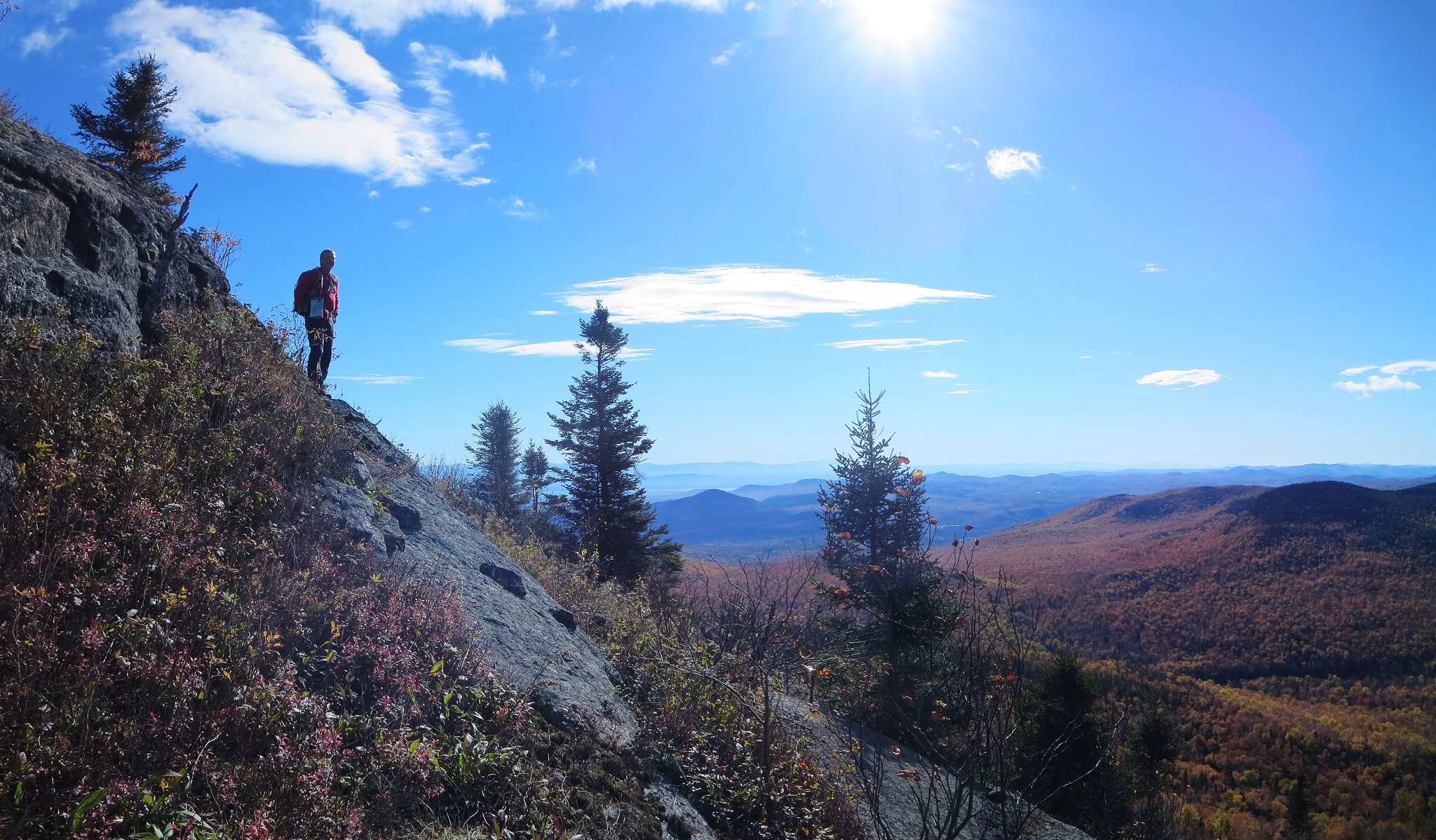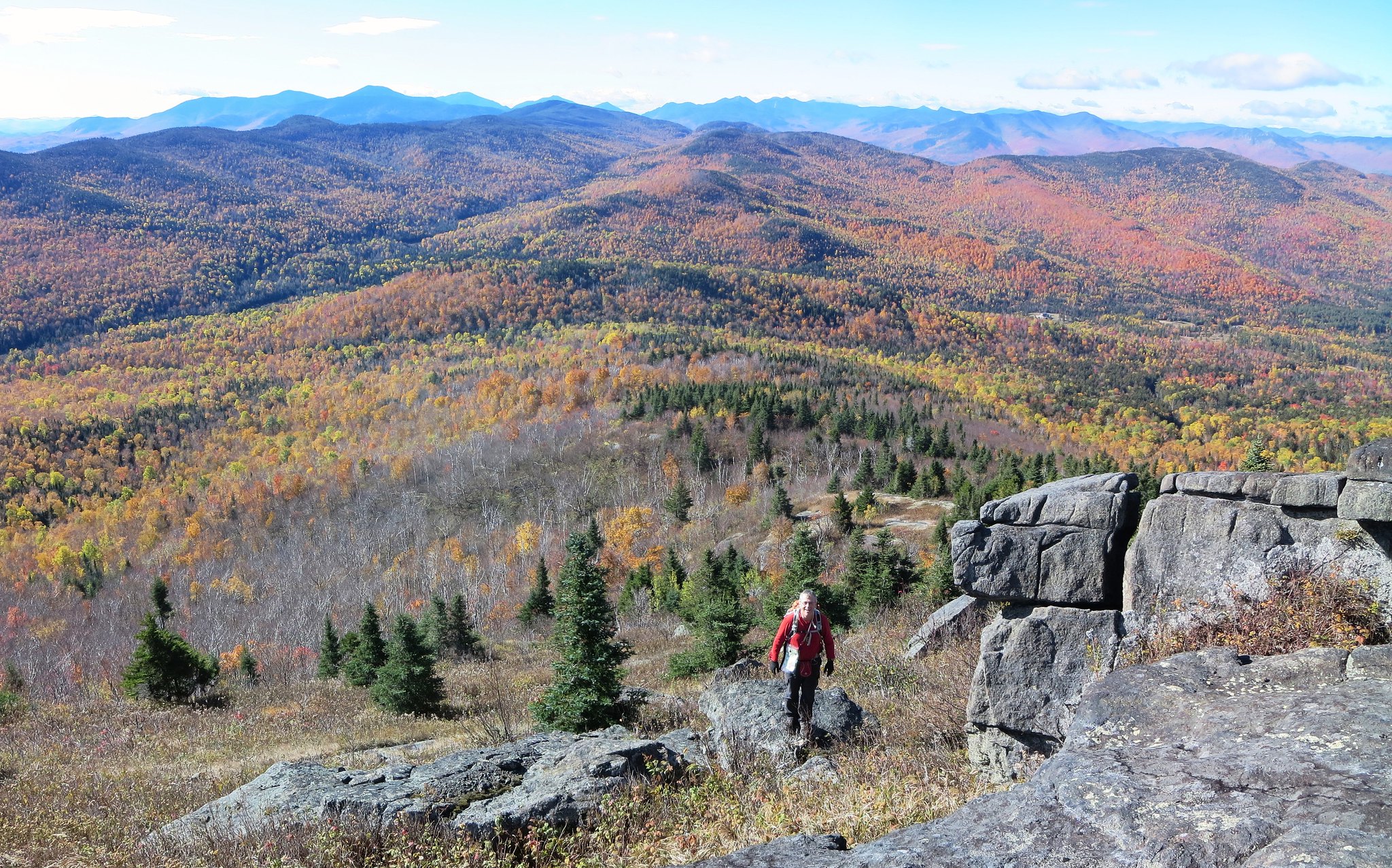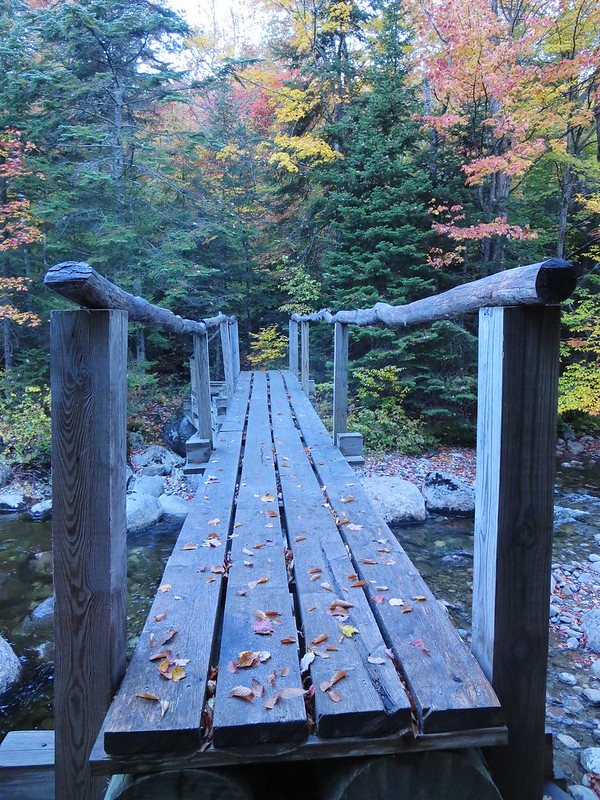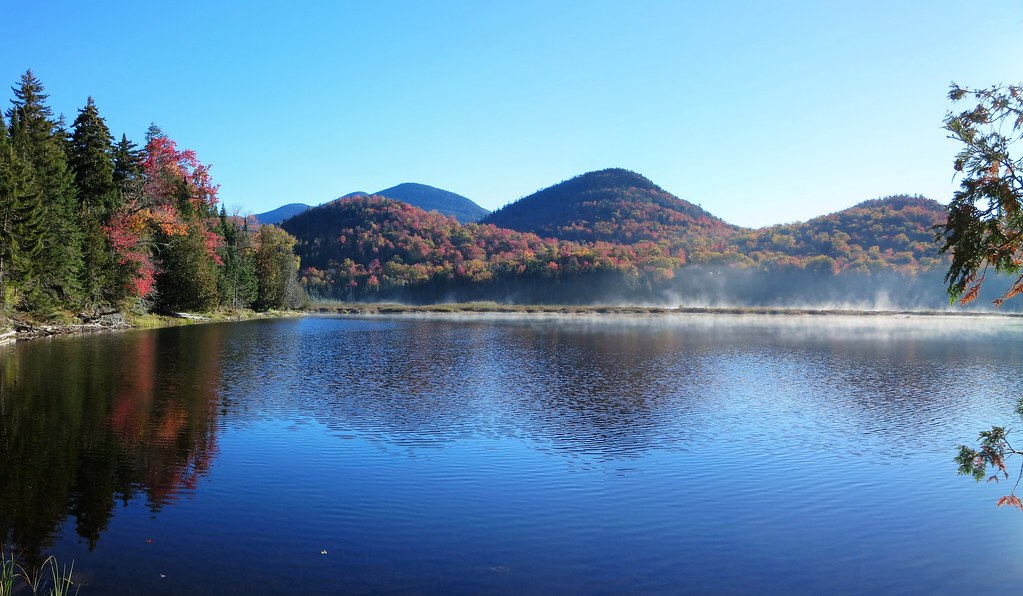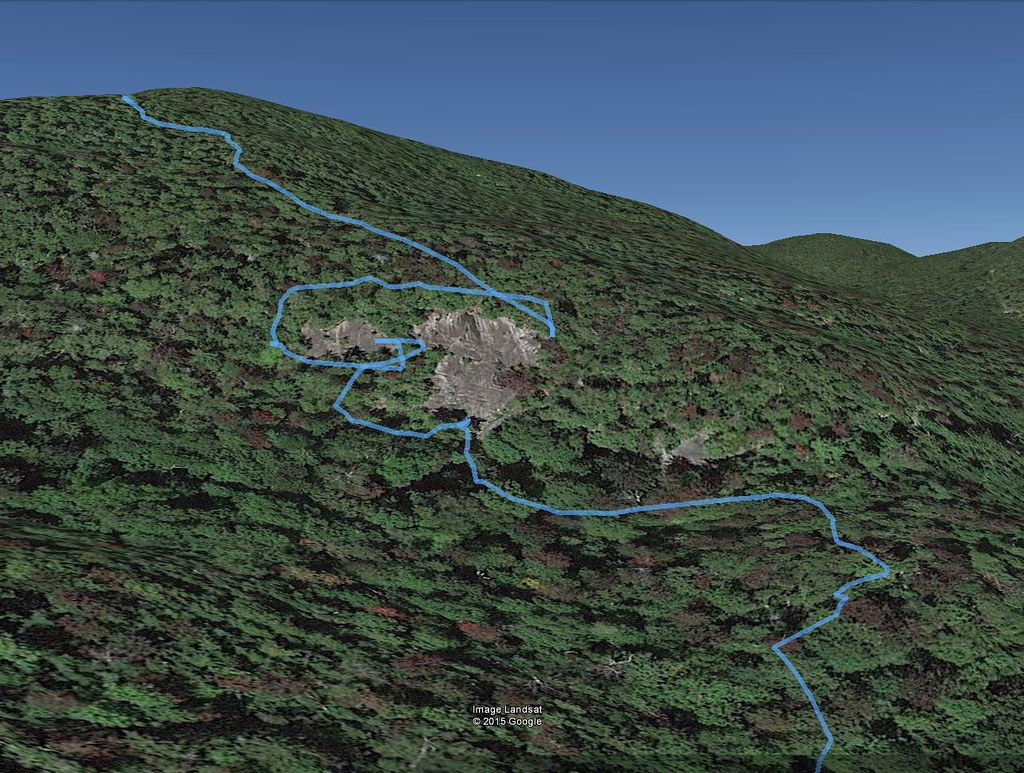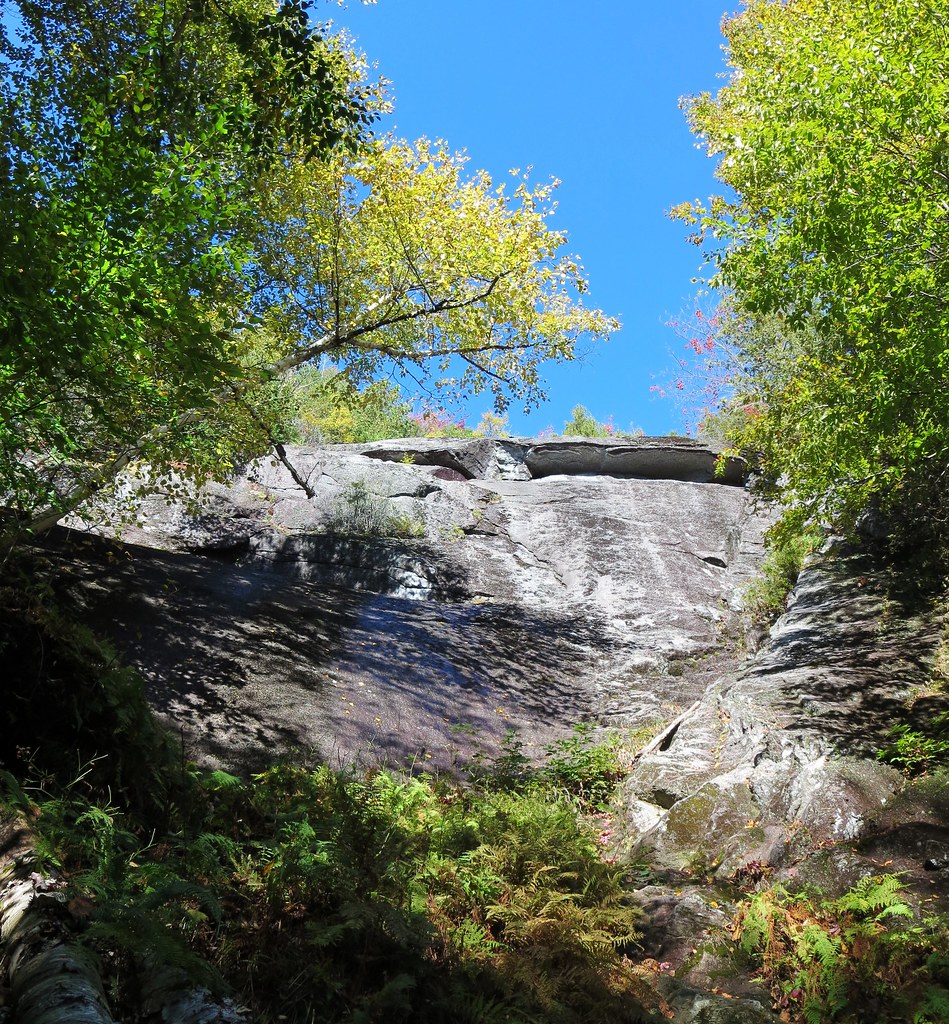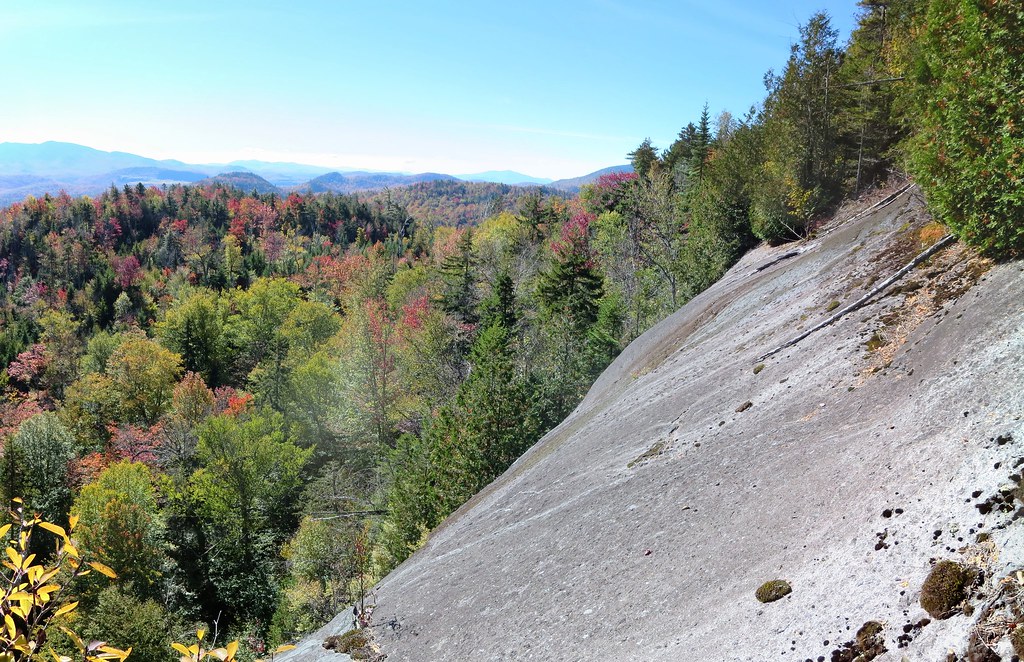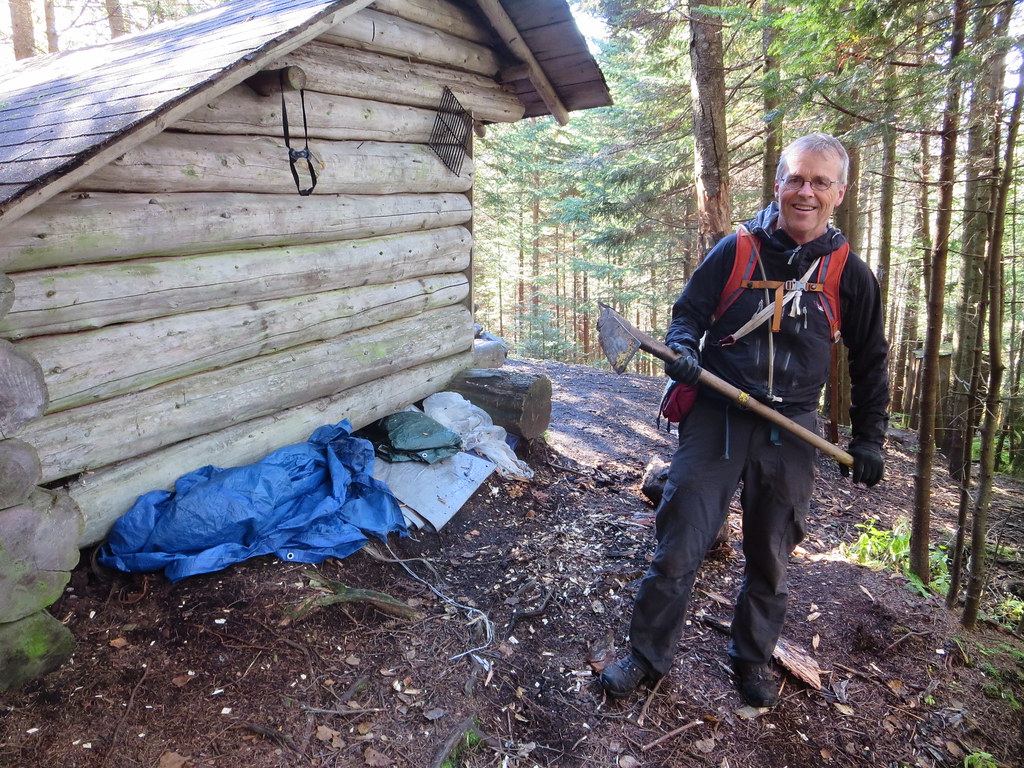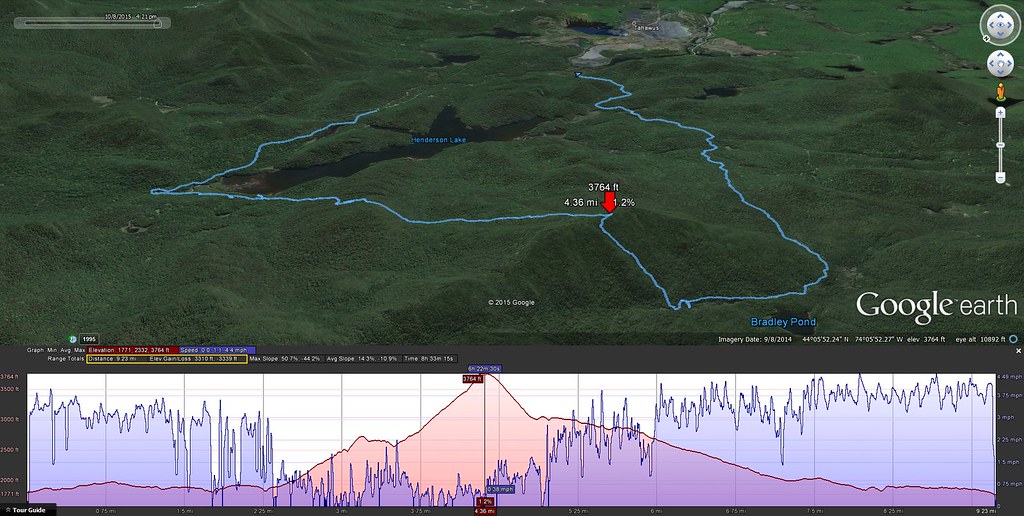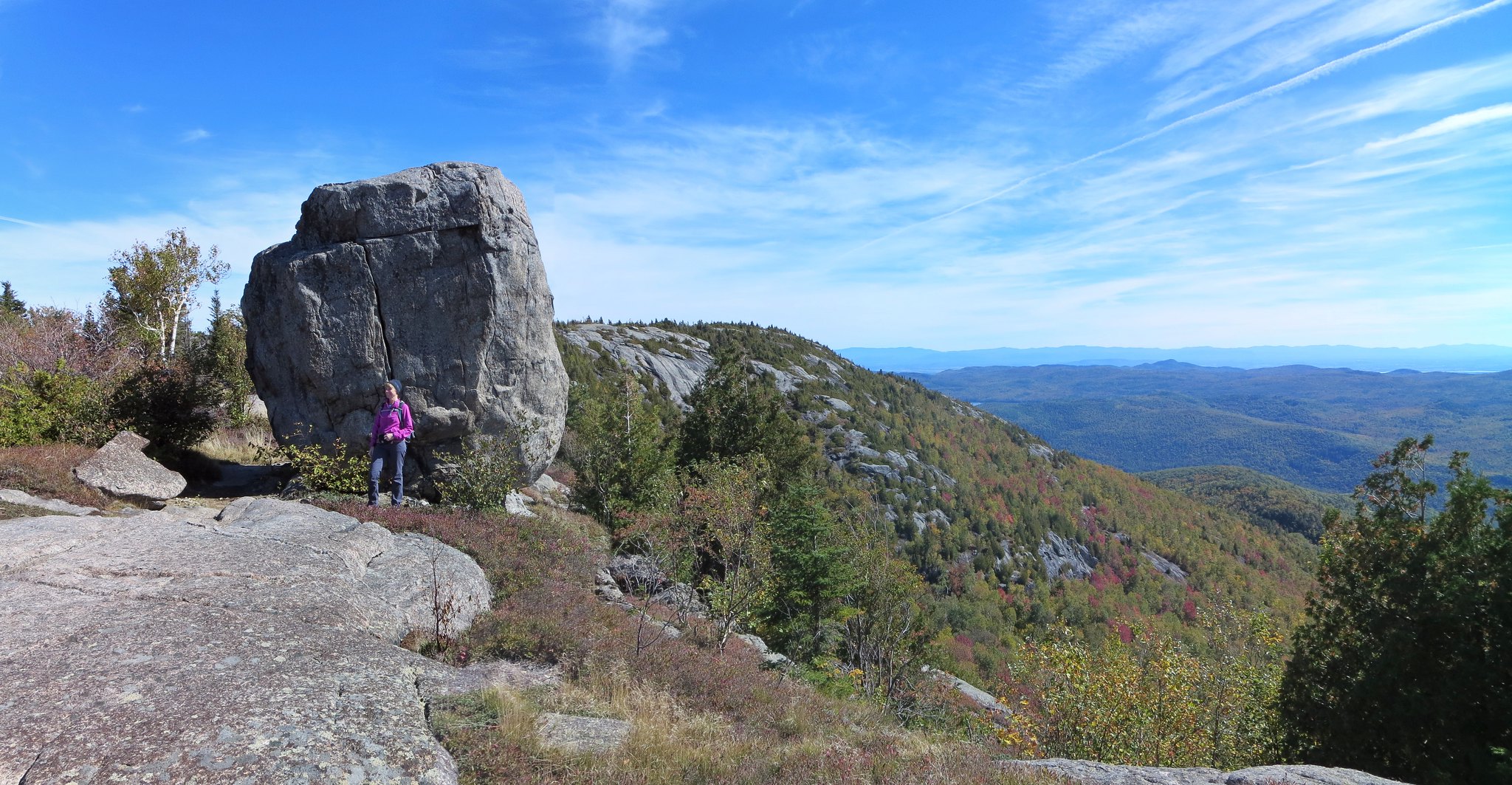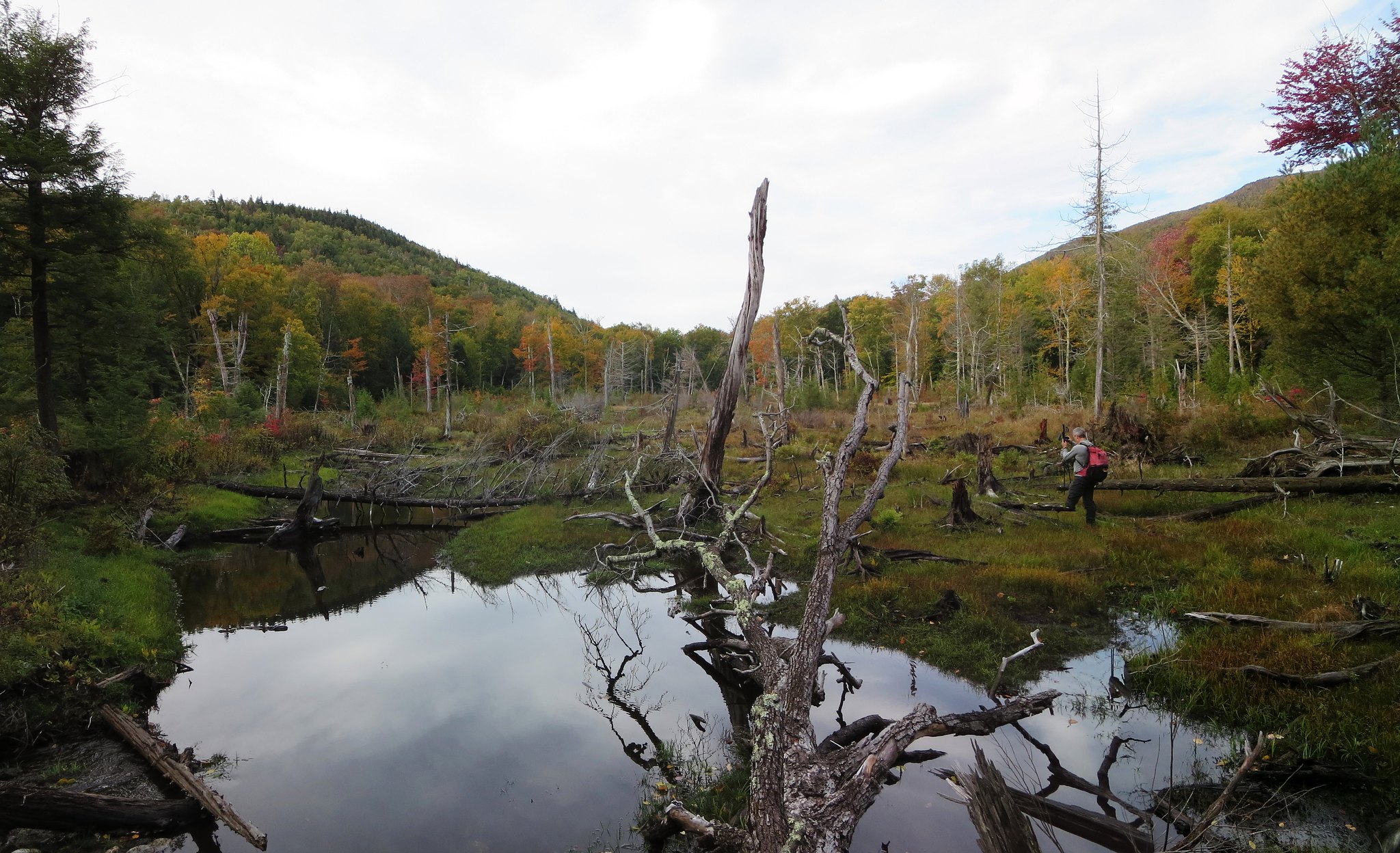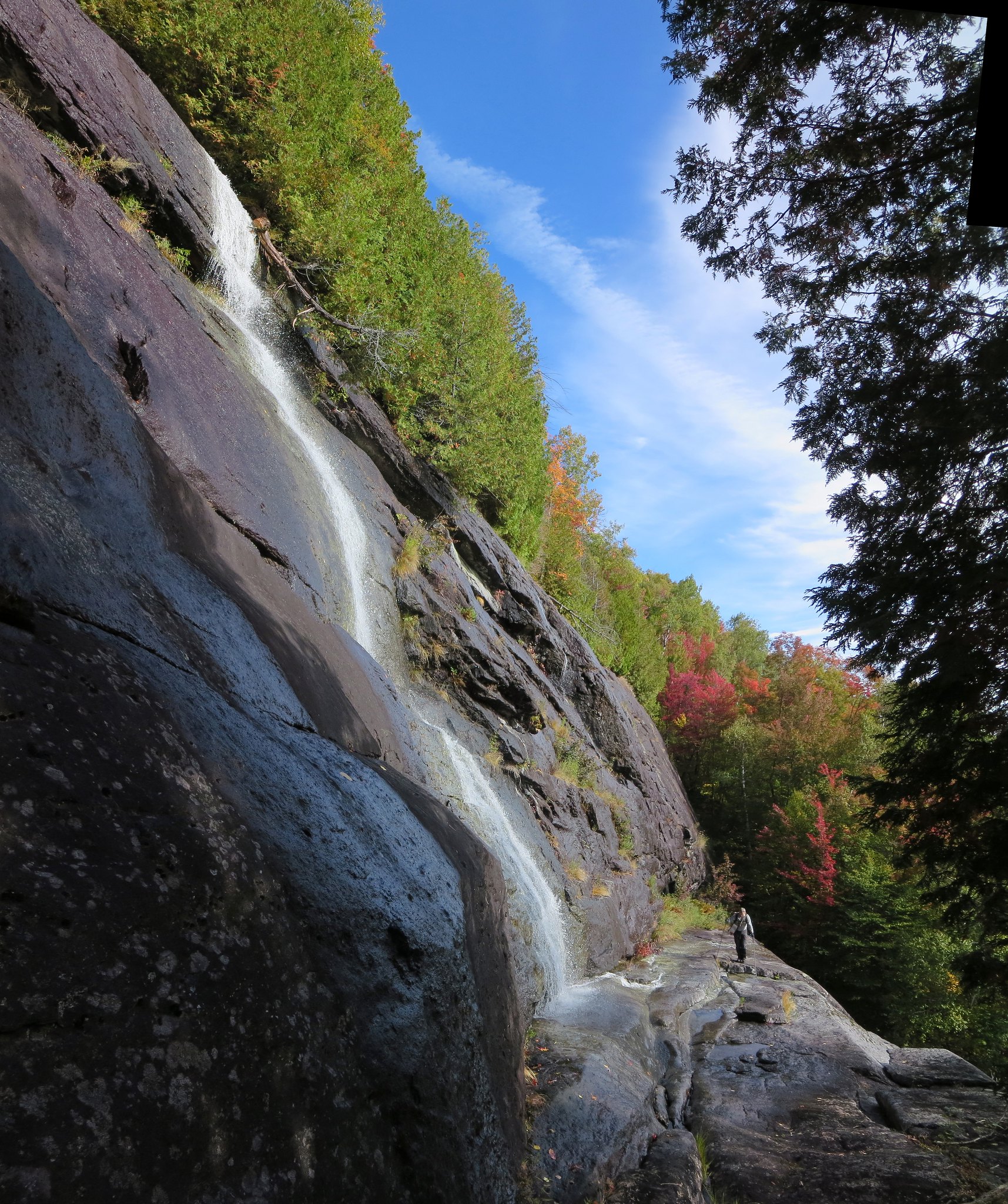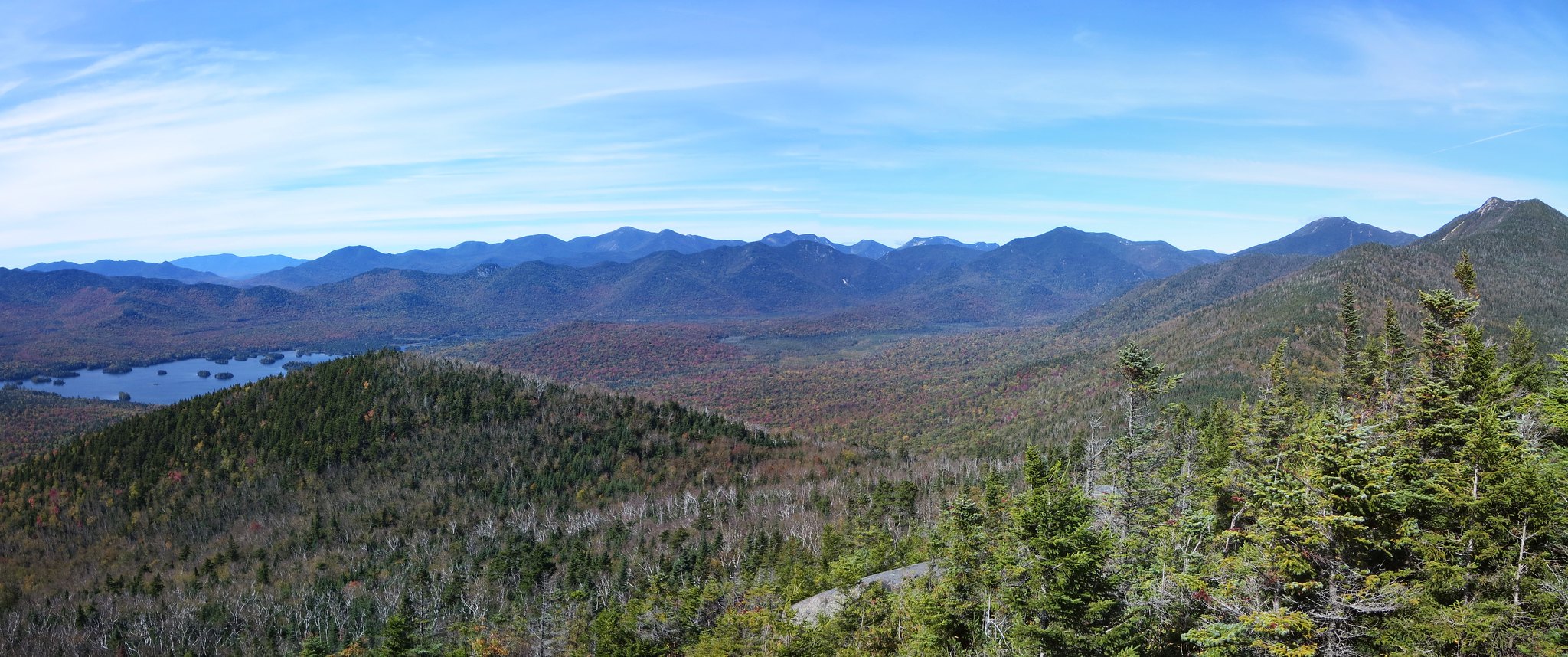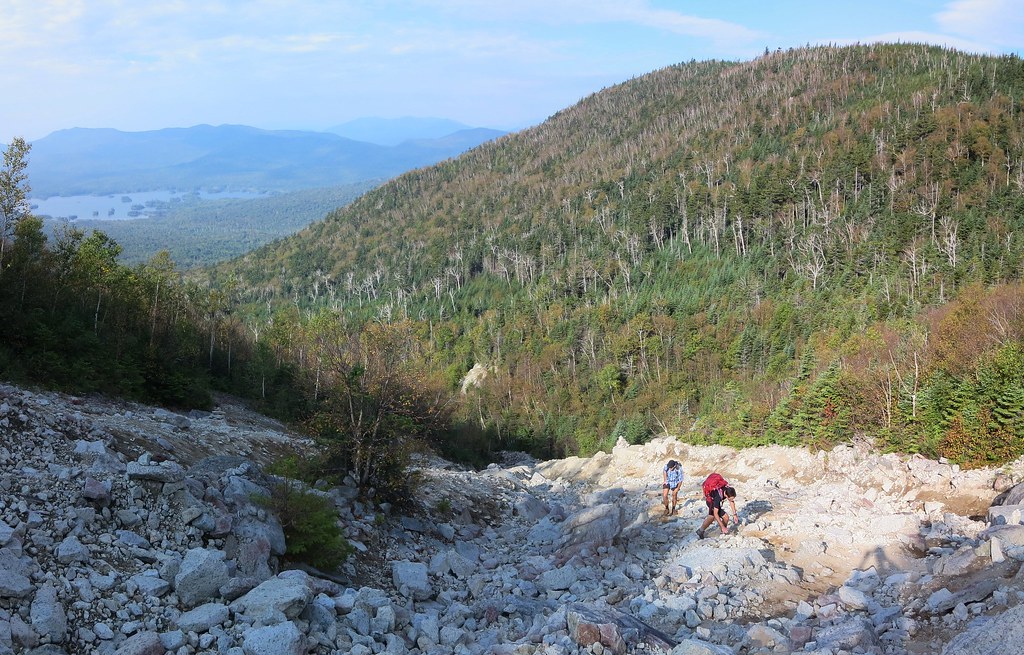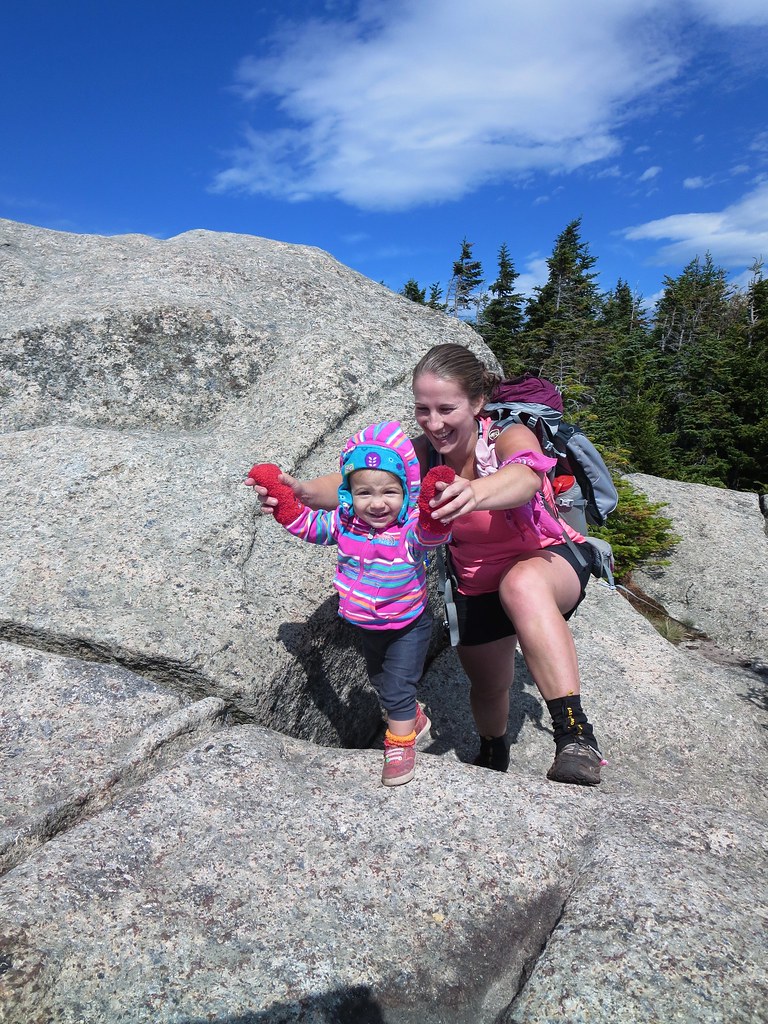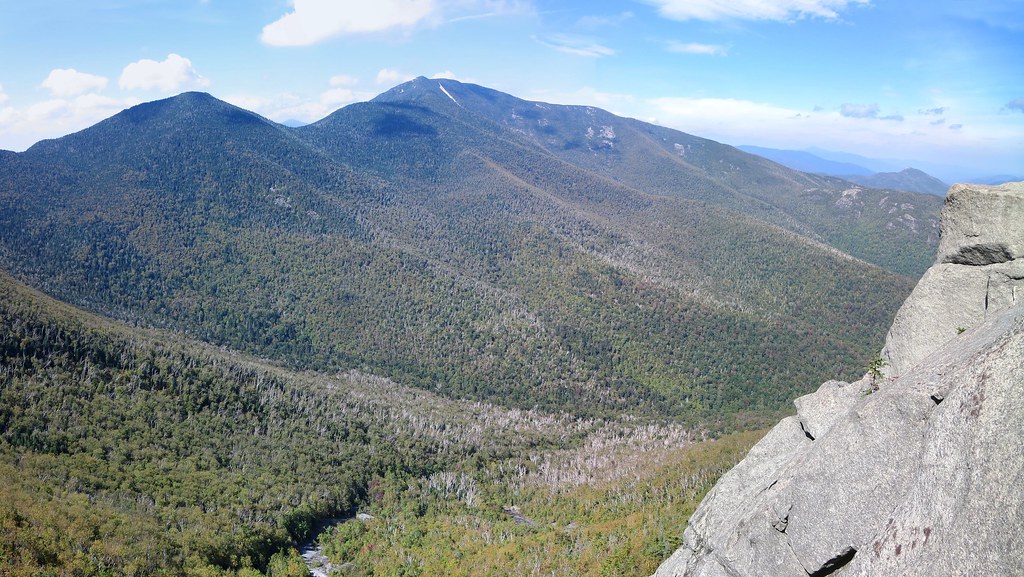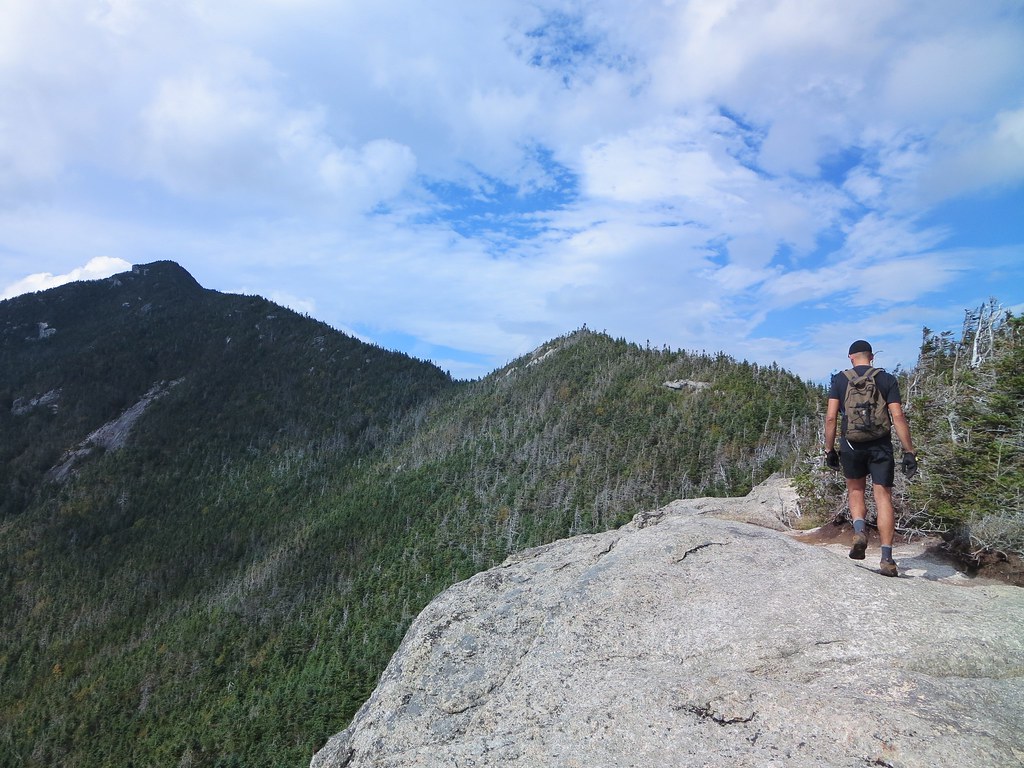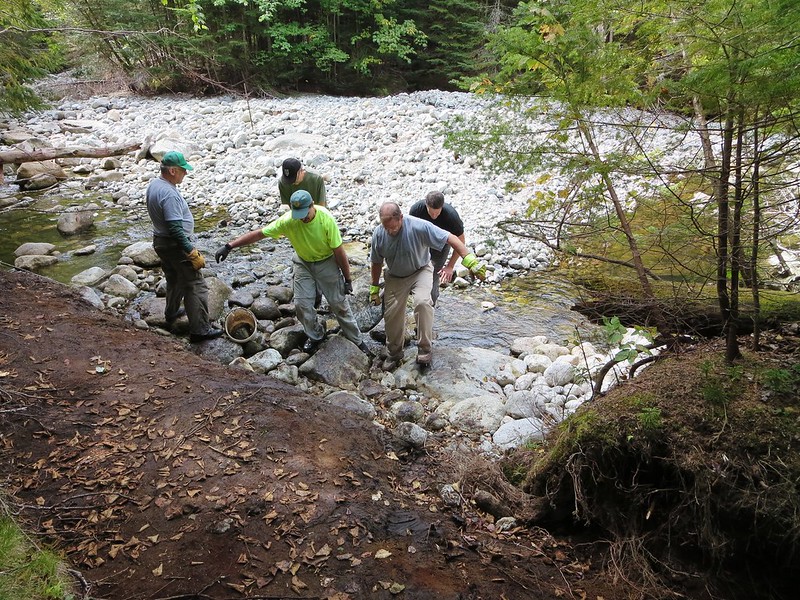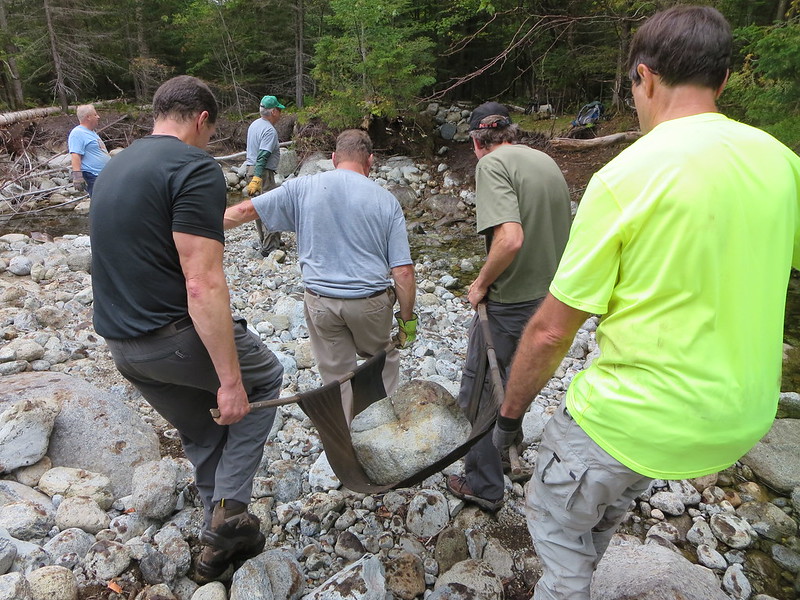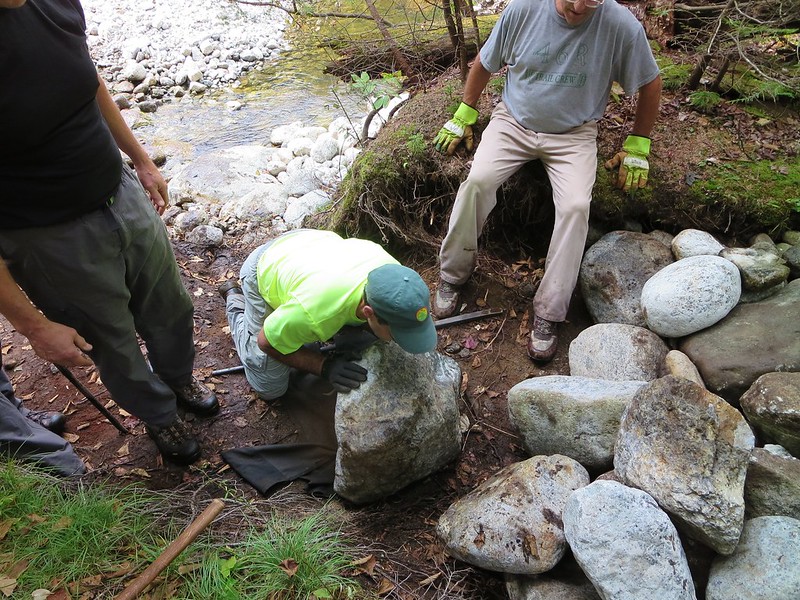Although the MOAC group was bound for Colvin and Blake, the team leader graciously allowed me to do my own thing. When one of the group members, Vladimir, learned I was going to Giant and RPR, he asked to join me. I asked that he get clearance from the team leader. With permission granted, we set off along the Roaring Brook trail.
My personal best for Giant and RPR is four hours in snowy, late-winter conditions. Today's effort was not competitive in nature and would break no records. The goal was to safely get up and down the icy trails and provide Vladimir ample time to enjoy his first trip to Rocky Peak Ridge (RPR).
A light snowfall the previous night had whitewashed the frozen ground and ice. I soldiered along in bare-boots until the second slip, on snow-obscured ice, signaled it may be prudent to add spikes. Now the game was reversed. Without traction, I had sought rock and avoided ice. Now armed with sharp points, I avoided rock, to prevent needless dulling, and searched for ice. Vladimir wore trail-worn Kahtoola Microspikes whereas my boots flashed the freshly sharpened teeth of Hillsound Trail Crampons. The day's journey would prove it wasn't a fair fight.
Roaring Brook flowed freely. Rather than rock-hopping the snow-covered rocks, we crossed by walking on the shallowest submerged rocks. It seemed safer to me than jumping on rocks and discovering a veneer of ice beneath their snowy blanket.
We made good progress until we reached the first of many ice flows. The ice had had ideal freeze-thaw conditions to grow over the span of weeks of mild weather. However, it was no longer yielding and Microspike-friendly. The cold morning air had made it bulletproof. Vladimir struggled to gain purchase with his spikes and lost confidence in their holding power. My Trail Crampons held securely but I was careful to plant them squarely and "flat-footed" wherever it was practical. The hardened ice slowed our ascent and I paused to allow Vladimir to creatively ascend the iciest sections. The ice softened later in the day and he was able to descend with greater confidence. Nevertheless, I imagine he will either sharpen or purchase new Microspikes after this trip.
I wished I had brought my thermometer because I was curious to know the temperature. It seemed colder than advertised because my fingers became uncomfortably cold. They have become prone to chilling to the point of causing stiffness and pain. I paused to add mitten-shells and hand-warmers. Vladimir seemed unaffected by the cold and, at least for a short while, wore no gloves or mitts. Perhaps it wasn't as cold as I thought but my hands tacitly disagreed.
About a hundred yards before the Roaring Brook trail meets the Zander Scott trail, a "false trail" joins it. I recounted an anecdote to Vladimir about how it looks like a proper trail in winter. It had caused us some confusion because one of our party used it for a butt-slide and failed to appear at the trail-junction. This morning, filled with fallen trees, no one could possibly mistake it for a trail.
At the RPR junction we met the first of a handful of hikers we would see all day. He was waiting for his partner to return from RPR. We pressed on and arrived at a steep pitch with a dangling, weather-beaten rope. My first instinct is to remove all "user-based trail-modifications". However, I temporarily left the rope in place just in case someone ahead of us had left it there for their return.
Giant's summit was shrouded in a cloud bank. It was my fourteenth visit, so it wasn't like I had never seen its views. The rolling fog added a touch of moodiness to the scene. We stayed only long enough for a snack and then my toes signaled it was time to either add a layer or get moving. We left at a brisk pace, eager to add RPR to Vladimir's growing list of ADK peaks.
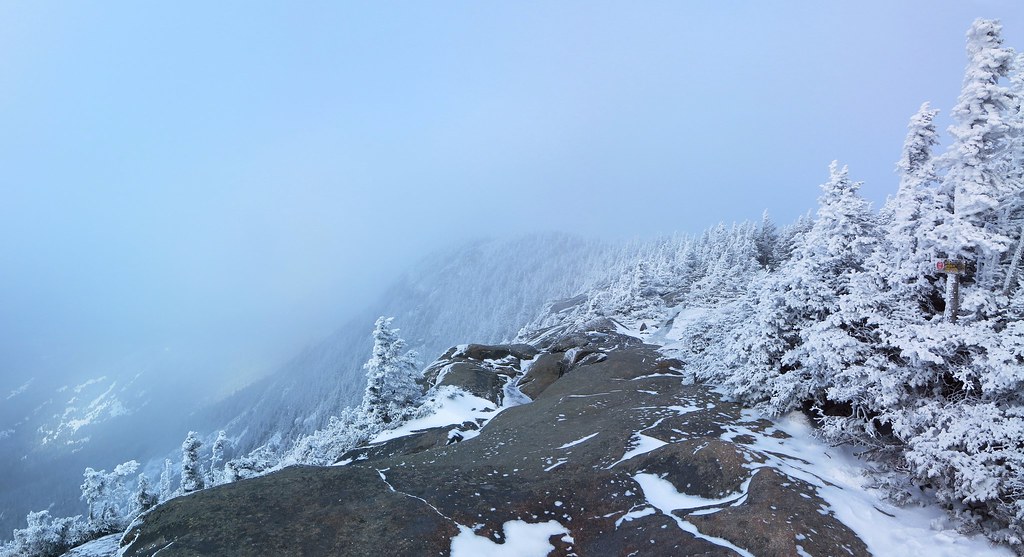 |
| My 14th visit to Giant and it's a foggy one. |
Before beginning our descent into the col, I cautioned Vladimir it would be steep and icy. He confirmed his desire to proceed, with trail-worn spikes, and so we dove in. The "usual suspects" were iced over and didn't fail to challenge us. It seems all of them have developed obvious bypass routes except for the man-high ledge (above the junction with the spur-trail). However, hiker traffic and erosion have exposed so many tree roots that they form a natural ladder; this ledge isn't as tricky to scale as it was in the past.
The clouds had lifted and we arrived to sweeping views atop Rocky Peak Ridge. The westerly wind was nippy so we walked to RPR's eastern side and enjoyed our lunch in relative warmth. I pointed out Lake Marie-Louise to Vladimir and described the wonderful traverse from the New Russia trail-head. As always, the view east was like a siren-call to complete the traverse. Enticing but impractical considering it was unlikely we could hitch a ride back after dark.
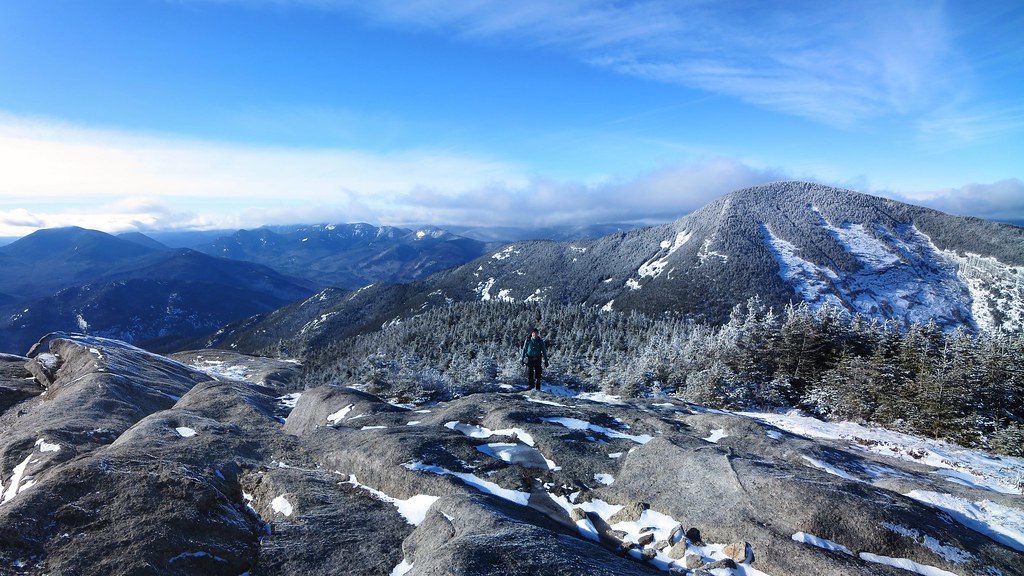 |
| Vladimir arrives on Rocky Peak Ridge. |
He wondered out loud why was I not hiking in the Sawtooths with Neil? He enjoys ribbing Neil about his obsession with bushwhacking the Sawtooth mountains. I explained Neil was the "Mayor of the Sawtooths" therefore he needed to be close to his constituents. Little did we know that Neil was in the Sentinels that day.
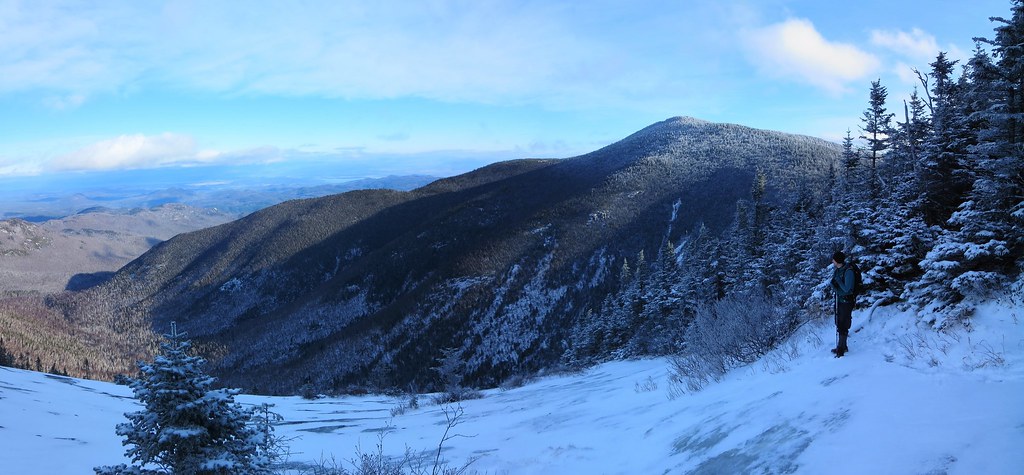 |
| Appreciating the view from one of Giant's eastern slides. |
Back at the weather-worn rope, I concluded whoever installed it was no longer on the mountain. I untied it, used it to belay Vladimir's descent, then stowed it in my pack. I was able to easily descend the pitch without the rope.
I had failed to manage my hydration system and the bite-valve was now frozen. Nothing I did let the water flow freely so I tucked the free end of the hose into my jacket so it would eventually defrost. This would have regrettable consequences a short while later.
We continued to the "Over bump/Around bump" junction where I chose "Over" and Vladimir chose "Around". We met a few minutes later, at the base of the bump. I proceeded to dismantle two user-built cairns and then noticed the cold discomfort of a wet pant leg. Cue the punch line to my favorite joke "Hey! You're Arnold Palmer!"
I opened my jacket and discovered the bite-valve and its winter-cover had fallen off. The hose had defrosted and, whenever the pack was compressed, allowed the water to flow out onto me. Phooey! I removed my pack and asked Vladimir to wait while I ascended the trail to find the valve. Its cover was turquoise-blue so it would be easy to spot.
I climbed all the way back to the base of the bump but could not find the valve. Perhaps it fell off above the bump but I felt it wasn't worth the extra time and effort. The search was equally fruitless during the descent. I had to tie back the hose several times because it always found a way to squirt water (on my back, head, pack, etc). It finally ceased to be a nuisance when the hose frozen again. I've used a hydration bag for two winter rounds of the 46 and never experienced this glitch. There really is a first time for everything.
At the Roaring Brook junction, we chose to extend our hike by descending the Zander Scott trail to Giant's Washbowl. We would turn north, pass the base of Giant's Nubble and close the loop at the Roaring Brook trail. It seemed like a nice way to return to our car without backtracking along the entire length of the Roaring Brook trail.
High above the Washbowl, at a point where the Zander Scott trail transitions from woods to open slabs, we met a small group of photographers preparing for sunset shots. The low-lying clouds in the west offered the possibility of either dramatic colors or an unceremonious extinguishment. For their efforts, I hope it was the former. As we closed in on the Washbowl, we met a group of hikers hustling upward. They were attempting to watch the sunset but I feel they may have arrived a little too late.
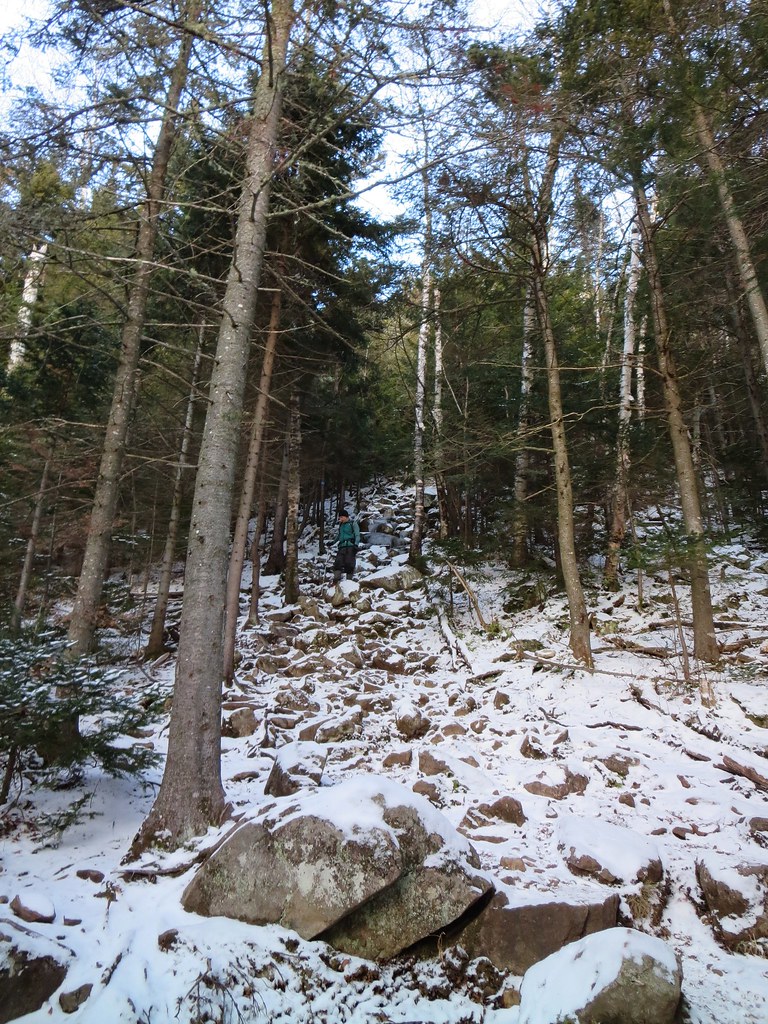 |
| A snow-free December. |
The Nubble's western cliffs loomed above us as we ascended to the height-of-land. The ice was now largely absent so I removed my Trail Crampons. The descent to the Roaring Brook junction was though open woods and made challenging only by the occasional patch of slippery leaves.
We crossed Roaring Brook in the same manner as we had in the morning. The failing light made following the trail a little more challenging. Ten minutes from the trail-head, I capitulated and donned my headlamp. Vladimir soldiered on in the dark. With improved visibility, I zipped ahead and quickly signed us out at the trail-register. A three-quarter moon had risen and cast its cold light on the snowless trees.
We arrived at the car and were joined by the MOAC group a mere five minutes later. The group leader was surprised to learn we had taken as much time as their (longer) tour of Colvin, Blake, and Indianhead. There wasn't much to say about it beyond the fact we encountered many steep pitches with hard ice (notably in the morning) and dull Microspikes added to the challenge. The smiles all around indicated everyone had a great day in the mountains and that's the best measure of all.
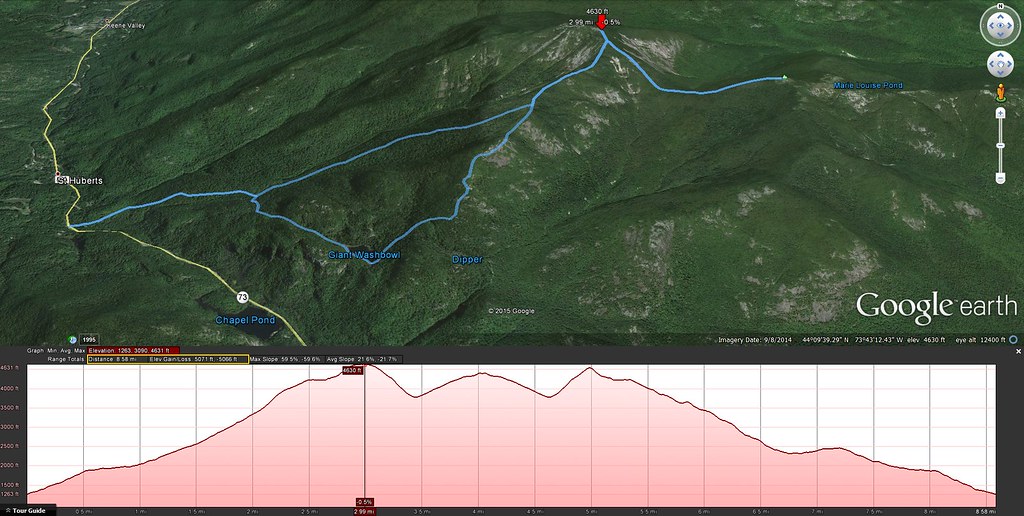 |
| Approximately 8.6 miles and 5070 feet. |

